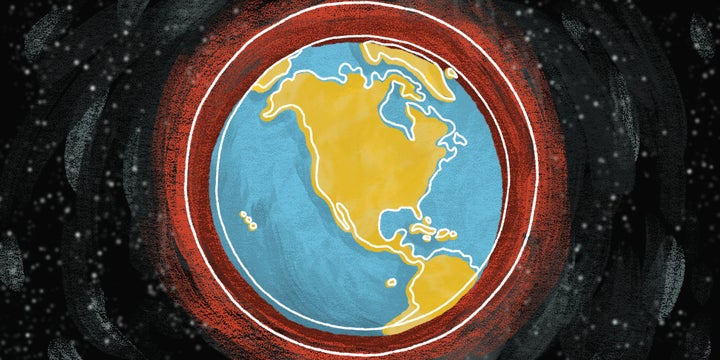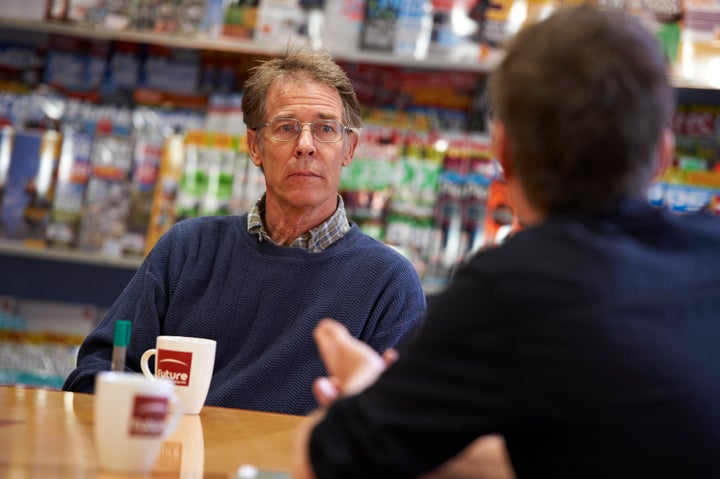
Kim Stanley Robinson’s most recent novel imagines a world rocked by a catastrophic rise in sea levels more than a century from now.
But in the weeks after a historic heat wave roasted much of the planet, the lauded science fiction writer’s concerns about geoengineering feel much more pressing.
“The revulsion against geoengineering has to be rethought,” Robinson told HuffPost. “If a hundred million people die in one heat wave, and the government of India says we’re going to imitate a volcanic explosion and throw dust into the air to block out the sun, are we going to tell them they can’t?”
The truth is the politics of large-scale intervention in the climate system rarely align with the promises of geoengineering.
Proposals to launch parasol satellites or spray sulfur dioxide gases into the atmosphere to reflect sun rays away from Earth? Grave threats, according to a study published in Nature this January, because if any government goes rogue, the effects could be disastrous.
Building underwater seawalls to prop up Arctic glaciers and slow down the melting in Greenland? An expensive venture that would only buy some time.
Giant fans that would suck carbon dioxide from the skies? A costly boondoggle that would encourage policymakers and pundits who reject climate science to maintain business as usual.
It’s not hard to see why some call geoengineering “the Big Bad Fix.”
Yet as fossil fuel emissions hit an all-time high and the nation that is the world’s top historic emitter abandons already fragile climate negotiations, the window for averting cataclysmic change by cutting greenhouse gases alone appears to be closing fast. That, at least to Robinson, makes geoengineering seem increasingly inevitable, despite the valid concerns over something that was once the stuff of science fiction and godly intervention.

Robinson’s New York 2140, published last year, lays out a vision of what climate catastrophe and a leftist uprising against the capitalist forces that caused it would look like. So HuffPost asked him to elaborate on what he sees as the future of geoengineering. The following was edited for length and clarity.
How do you define geoengineering and what are the forms it will most likely take?
I guess the definition would be something like “a deliberate planned attempt by human beings to mitigate the damages of climate change, of carbon dioxide and methane buildup in the atmosphere, and of ecological damage generally, by way of some action that is large-scale” — if not global in reach, then regional in ways that might have global repercussions.
I’ve been saying that “geoengineering” is a bad name because engineering implies we know what we’re doing more than we really do. Also, that we have more powers than we actually have. I’ve suggested we think of it as “geo-finessing” or “geo-tweaking” or even “geo-begging,” to better indicate our relative ignorance and weakness in the face of global geochemical processes. Lots of those processes we can’t do anything about, even if we really want to. So the name needs some unpacking.
The most likely forms it might take, I think, are the following: casting dust-like particles into the atmosphere to mimic a volcanic eruption, so that for a number of years after that, the global average temperatures would go down a bit. Drawing carbon dioxide out of the atmosphere by way of biological and/or mechanical means. Pumping seawater onto the ice cap of Eastern Antarctica. Stimulating growth of small life forms in the ocean that would then die and take their carbon to the seafloor ― this has been mentioned as a possibility, but it’s widely regarded as potentially dangerous for ocean ecologies. Still, it might be tested on small scales, even used on small scales, which would reduce its power to help but also its power to harm.
Why do you think people, particularly on the left, are so concerned about geoengineering?
Because we don’t know enough about it to be confident that anything we attempt in that way won’t cause even worse knock-on effects. It’s a legitimate concern, although it can be exaggerated. Casting particles into the atmosphere might harm the monsoon ― yes, that’s a real concern. But thinking it will cast us into an ice age is not paying attention to what [Mount] Pinatubo’s eruption did nor to the physics of the situation.
So it’s a question of paying close attention to the science we do have and then making judgments accordingly. As a leftist, I think there is a bad tendency among some leftists to conflate science with capitalism. They are not the same. I am against capitalism, I am for science. What we need is science guided by its own scientific methods when doing the science ― then guided by a leftist tilt toward justice and sustainability when it’s put to use. We need to choose to put science, technology, engineering and medicine to good human and biosphere work, rather than let it be bought to serve profit for the few most wealthy.
OK, so give me the socialist utopian case for geoengineering.
If it’s done by international agreements, or even by single governments acting on their own, it would be a social action. Possibly a sign of desperation, but a socialized act. If it were done by some individuals deciding to act on their own, it would be an individual’s action. So it depends on how it happens.
Say global average temperatures rise so high that the heat waves become deadly. This could happen. If a heat wave kills a hundred million people in some country, and that country decides to imitate a Pinatubo-sized volcanic eruption artificially to cool temperatures for five years, it may not matter whether that government is left or right. They will defend themselves to the world, and I don’t know what the world could say or do at that point. It would be a case of desperate measures for a desperate time.
So this is getting into a very science fictional area, a kind of thought experiment that follows the trajectories of where we are going now. If we get to a bad enough state with the climate and Earth’s biosphere generally headed for a mass extinction event that will hammer humanity, the utopian aspect of it gets a little into the negative side, but it is still there ― which is to say, if we can get out of the 21st century without a mass extinction event, that’s looking pretty utopian right now! So get used to that, admit the trajectory we are on, and start thinking of all possible solutions, or rather mitigations, as being on the table for consideration.
How do you make geoengineering equitable?
If democratically elected representative governments were to agree with each other to do it, using existing treaty systems and the U.N., the Paris Accords, etc., and it kept millions of people (often the least culpable when it comes to fossil fuel burning) from dying, then I guess you could say it was equitable.
What’s the worst-case scenario you can imagine?
Mass extinctions of thousands of species, agricultural disruptions leading to food shortages, and resulting social-political chaos, including war; thus mass death for humans, by way of hunger, heat waves, war. Sea level rise flooding all the beaches of the world and all the seaports, thus disrupting fishing, agriculture, world trade, and so on. The worst-case scenario, entirely possible given the trajectory we are on now, is VERY BAD. No one alive today should be fooling themselves about this.
And the best-case scenario?
The best-case scenario is also completely possible from our current situation, despite the trajectory we are on. It would be a just, sustainable world in which the energy flows in the biosphere were in balance, such that the extinction rates would be normal, ecosystems everywhere restored to health, and 10 billion humans ― shrinking quite naturally in number as all the women in the world began living in complete gender equality ― were all living with adequate food, water, shelter, clothing, health care, education, and work.
This best-case scenario, the utopian turn, is physically possible if it were the goal of human civilization and became what we were all working toward together. The crucial technologies involved are not so much physical as they are social, which is to say, we have to have ecologically guided economics and politics. It is by its very nature a leftist vision, in that it foregrounds justice and welfare for all.
How has the way you write about geoengineering in your books changed over time?
My Mars trilogy can be read as a big metaphor for geoengineering, as practiced on Mars and called terraforming. Many of the considerations, both technical and social, are much the same. It’s a way to think about the issues involved.
Then my Antarctica was about paleoclimate and what has happened on Earth in the past.
Then in Green Earth, I wrote about the Gulf Stream stalling, which is probably what happened in the Younger Dryas [period], when the global climate went from warm and wet to cold and dry in three years. That was a span of time a novel could handle, and people were speculating that the rapid melting of Greenland’s ice might stall the Gulf Stream again, causing another such radical quick change in global climate. Could we do anything about that? That novel, which first appeared in trilogy form beginning with Forty Signs of Rain, explored that scenario. It isn’t considered the likeliest scenario now, but again, the considerations are the same.
Then in New York 2140, I explored the ramifications of rapid sea level rise, a possibility that was pointed out in a paper by [climatologist] James Hansen, et al., when I was writing the book.
Those have been the major explorations in stories so far. I think I’ll have to try again with another scenario. No one can predict the future that will really come ― that’s impossible. But scenarios can be outlined as a kind of modeling exercise, to help us make decisions about what to do now to get to a future we want. It’s the story of the century so it makes sense to keep coming back to it.
Does most science fiction help or harm the public perception of geoengineering?
I don’t know. I’ve only read a small portion of contemporary science fiction, and geoengineering has seldom come into it. My impression is that some movies have portrayed geoengineering as a hubristic techno silver-bullet response that is sure to screw things up. It’s a version of the old “there are some things mankind is not meant to know,” blah blah. Also, to be fair, an extrapolation from certain hubristic power fantasies at earlier moments of history, like DDT in the streets, thalidomide, free nuclear power for all, etc.
It’s a desperate enough idea to create doubts it can succeed, and it also suggests a kind of moral hazard, in that if we think we can tech our way out of a disaster, we won’t do the daily little things that are needed as part of the solution. So skepticism is in order, and no one, not even scientists calling for more research, is happy about the idea of geoengineering as such. So whether science fiction helps or harms public perception, I’m not sure. When I write my stories, I’m trying to clarify my own thoughts.
Are you afraid for the future?
Yes.
What makes you most hopeful for a future in which humans who aren’t ultrarich can still thrive?
Progressive taxation, progressive politics, the Paris Accords, the Endangered Species Act, leftists everywhere on Earth including China, environmentalists everywhere, the growing green-red coalition or united front of environmentalists and leftists, the creative power of STEM, the humanist traditions in philosophy, people’s concern for their children, the growing sense of a “global village” we are all part of, the urge to survive. These are some of the things that make me hopeful. Hope is stubborn. It exists in us at the cellular level and works up from there, as part of the urge to live. So hope will persist. The question is, can we put it to use?
